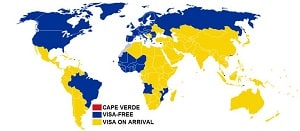Music and Dance in Cape Verde

Music and dance are central to Cape Verdean culture, reflecting the islands’ rich history of African, Portuguese, and Creole influences. Whether it's a soulful morna, an energetic funaná, or the rhythmic beat of batuque, music is everywhere—from lively street festivals to intimate gatherings. Dance, naturally, is never far behind.
1. Cape Verde Music and Dance Morna
- Cape Verde’s Most Iconic Genre
- Often compared to Portuguese fado, morna is slow, emotional, and poetic, typically about longing, love, and the sea.
- Instruments: Violin, guitar, cavaquinho, and piano.
- Notable Artist: Cesária Évora, the "Barefoot Diva," brought morna to the world stage.
- Typical Dance: A slow, elegant partner dance that reflects the genre’s melancholy tone.
2. Cape Verde Music and Dance Coladeira
- Livelier Cousin of Morna
- Faster tempo and more upbeat, often humorous or flirtatious in tone.
- Dance Style: Couples move with a rhythmic sway, closer in style to Caribbean dances.
- Instruments: Guitars, percussion, and sometimes accordion or brass.
3. Cape Verde Music and Dance Funaná
- Energetic and Political
- Originating on the island of Santiago, funaná was once banned during colonial rule. It combines a fast tempo with satirical or socially conscious lyrics.
- Instruments: Gaita (accordion) and ferrinho (metal scraper).
- Dance Style: Fast footwork with high energy, often danced in pairs.
4. Cape Verde Music and Dance Batuque
- One of the Oldest African-Based Styles
- Traditionally performed by women in a circle, batuque uses body percussion and call-and-response singing.
- Batuque Dance Style: Involves hip movements and rhythmic clapping; often performed in a communal, ritual setting.
- Batuque Cultural Roots: Strongly tied to African heritage and once linked to resistance against colonial authority.
5. Cape Verde Music and Dance Tabanka
- Festival Music with African Roots
- Accompanied by marching bands and parades, especially during the Tabanka festivals on Santiago Island.
- Tabanka Dance Style: Processional, often with traditional military-style drumming and costumes.
- Tabanka Cultural Role: Symbolic of Cape Verdean identity and resistance.
6. Cape Verde Music and Dance Zouk and Kizomba
- Zouk and Kizomba Pan-African Influence
- These genres, originally from the French Caribbean and Angola respectively, are also popular in Cape Verde.
- Zouk and Kizomba Dance Style: Smooth, sensual partner dancing—often seen at parties and nightclubs.
7. Cape Verde Modern Music and Fusion
- Cape Verdean artists blend traditional genres with reggae, pop, jazz, and hip-hop.
- Cities like Mindelo (São Vicente) and Praia (Santiago) are cultural hubs for modern music scenes.
- Young artists continue to evolve the sound while honoring tradition.
8. Cape Verde Music and Dance Deserts and Dunes
- Parties and Gatherings: Music is almost always playing, and dancing is spontaneous and joyful.
- Carnival and Festivals: Huge street parades with costumed dancers and live bands—especially famous in Mindelo.
- Cultural Performances: Many hotels and cultural centers offer traditional dance performances for tourists.
9. Cape Verde Music and Dance Learning and Participating
- Workshops & Classes: Some communities and tourist centers offer dance or drumming lessons.
- Joining Locals: Visitors are often invited to dance during community events—participation is welcomed, even if your steps aren’t perfect!
10. Cape Verde Music and Dance Notable Artists and Groups
- Cesária Évora – The queen of morna.
- Tito Paris, Lura, Mayra Andrade, Elida Almeida Contemporary artists mixing tradition and innovation.
- Ferro Gaita Known for their powerful funaná performances.
Cape Verde Music and Dance Conclusion
Music and dance are the heartbeat of Cape Verdean life. Whether you’re listening to the haunting strains of morna, swaying to coladeira, or joining in a batuque circle, the rhythms of Cape Verde tell the story of its people—resilient, joyful, and always moving.
7. Cape Verde Online Visa
The Cape Verde eVisa allows travelers to enter the Cape Verde for tourist purposes. The Cape Verde Pre-Arrival Registration allows applicants a Single Entry to Cape Verde, The visa allows you to stay for 90 days. You must enter the country within 180 days after the visa has been issued. Cape Verde eVisa
Cape Verde Adaptability: Despite challenges, Cape Verdeans are known for their resilience and resourcefulness.
Cape Verde Festivals and Celebrations
Cape Verde Carnival: Celebrated with parades, music, and dance, particularly on São Vicente and Santiago.
Cape Verde Saint’s Day Festivals: Each island celebrates its patron saint with processions, feasting, and traditional music.
Cape Verde Travel Communication: Learn a few basic phrases in Portuguese or Creole. Having a local SIM card or an international roaming plan can help you stay connected.
Stay Informed: Keep informed about local news and weather updates, especially during the rainy season when travel can be disrupted.
Cape Verde nature and wildlife Conclusion
Cape Verde offers a wealth of opportunities for nature and wildlife enthusiasts, from exploring volcanic landscapes and lush valleys to encountering rare birds and marine life. Whether you’re hiking, birdwatching, or simply relaxing by the sea, Cape Verde’s natural beauty provides a serene and unforgettable experience.





 |
|  |
|  |
|  |
| 